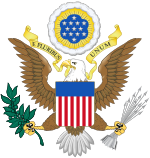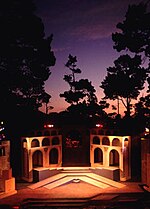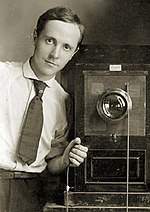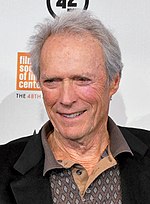Timeline of Carmel-by-the-Sea, California
Appearance
(Redirected from Doud Building)
This article contains close paraphrasing of non-free copyrighted sources. (August 2024) |
The following is a timeline of the history of Carmel-by-the-Sea, California, United States.
| Date | Event | Image | Ref(s) |
|---|---|---|---|
| 1771 | Mission San Carlos Borromeo de Carmelo (Carmel Mission) was moved from Monterey to Carmel on August 1, 1771; the first mass was celebrated on August 24, and Junípero Serra officially took up residence in the newly constructed buildings on December 24, 1771. | 
|
[1] |
| 1853 | Known as "Rancho Las Manzanitas", the unoccupied area of wooden hills that became Carmel-by-the-Sea was purchased by French businessman Honoré Escolle in the ca. 1853. He bought the land for pasturage and firewood. | 
|
[2] |
| 1859 | William Martin of Scotland arrived in Monterey in 1856 by ship with his family. His son, John Martin, bought land around the Carmel River in 1859 from broker Lafayette F. Loveland. He built the Martin Ranch on 216-acre (0.87 km2) that went as far as the Carmel River to the homes along Carmel Point. The ranch became known as the Mission Ranch because it was so close to the Carmel Mission. | 
|
[3] |
| 1870 | The United States government patent gave the Carmel Mission Church 7-acre (0.028 km2) of land. | 
|
[4] |
| 1880 | The branch line of the Southern Pacific Railroad between Castroville and Monterey, California was completed. It was called the Del Monte Express. Charles Crocker chose Monterey as the site for a new seaside luxury hotel, which would be called the Hotel Del Monte. It was thought that the Southern Pacific would extend the line to Carmel. | 
|
[5][4]: 220 |
| 1884 | Work began on the repair of the Carmel Mission Church. Leland Stanford led the fund-raising effort that involved more than 50 citizens of California. | 
|
[4] |
| 1888 | Escolle and Santiago J. Duckworth, a young developer from Monterey with dreams of establishing a Catholic retreat near the Carmel Mission, signed an agreement to sell 324 acres (131 ha) to Duckworth and his brother on February 18, 1888. The land began at the top of the Carmel Hill and ran past the boundary of the Hatton Ranch, down through Ocean Avenue to Junipero Avenue. On May 1, 1888, they filed a subdivision map with the County Recorder of Monterey County. | 
|
[6][7] |
| 1889 | Abbie Jane Hunter, a realtor from San Francisco, bought seven Carmel City lots. She became a real estate associate with Duckworth, to help build a Catholic summer resort called Carmel City. | 
|
[2]: 9, 15 |
| 1889 | In 1889, Carpenter Delos Goldsmith (1828–1923), an uncle to Abbie Jane Hunter, built the Carmel bathhouse above the beach at the foot of Ocean Avenue to attract visitors to Carmel City. Hunter's son, Wesley R. Hunter (1876–1966) helped build it. It was torn down in 1929. | 
|
[2]: 15 [8] |
| 1889 | The first Carmel Post Office opened in 1889. | 
|
[9][2] |
| 1890 | Hotel Carmelo was one of the first buildings constructed along Ocean Avenue. In 1890, Carmel City trees were removed and an outline marked for the construction of Ocean Avenue heading east up the hill. | 
|
[10] |
| 1892 | Abbie Jane Hunter used the name Carmel-by-the-Sea in advertisements for the first. She founded the Women's Real Estate Investment Company and acquired 164-acre (0.66 km2) of the Carmel City Tract. | [2]: 16 [11]: 32 | |
| 1902 | City was founded in 1902. San Francisco attorney Frank Hubbard Powers purchased all the unsold land in Carmel with real estate developer James Franklin Devendorf who became his partner. They formed the Carmel Development Company on November 25, 1902, and established the artists and writers' colony that became Carmel-by-the-Sea, in 1903. | 
|
[12][6]: 8 [4]: 222 |
| 1902 (or 1903) | Richardson Log Cabin, is a historic building that was built in 1902 (or 1903), by George H. Richardson, an Alameda attorney. The structure is recognized as one of the oldest residential buildings in Carmel and the earliest known residence of American poet Robinson Jeffers and his wife Una. | 
|
[13] |
| 1903 | The Carmel Development Company Building was the first "modern" commercial building in Carmel built by Thomas Albert Work of Pacific Grove, California, in 1902–1903, on the northwest corner of San Carlos Street and Ocean Avenue. | 
|
[11] |
| 1903 | Louis S. Slevin photographed Carmel in 1903, and was the first to open a general merchandise store in 1905. He was also the first postmaster and town treasurer. | 
|
[6] |
| 1905 | The Carmel Arts and Crafts Club was founded in 1905, by Elsie Allen, a former art instructor for Wellesley College. The club was located at Monte Verde Street where the Golden Bough Playhouse is today. The clubhouse served as the Carmel community cultural center. Between 1919 and 1948 Carmel was the largest art colony on the Pacific coast. | 
|
[14] |
| 1905 | Writers Mary Austin, Jack London, James Hooper, Arnold Genthe, and George Sterling came to Carmel. In 1905, Sterling bought property between 10th and 11th Avenues. | 
|
[4]: 241 |
| 1906 | The Sunset School was Carmel's first public school founded in 1904, moving in 1906 to San Carlos Street. In 1907, there were only 30 children and one teacher. | 
|
[12] |
| 1908 | Carmel fire department was established in 1908 by twenty citizens that was led by Robert George Leidig (1879–1970). | [6] | |
| 1910 | Dr. Daniel T. MacDougal of the Carnegie Institution established the Coastal Botanical Laboratory at the Outlands in the Eighty Acres, with some scientists moving to the Carmel area. | 
|
[15] |
| 1910 | The Forest Theater Society was founded by Herbert Heron. The first theatrical production, David and Saul, a biblical drama by Constance Lindsay Skinner under the direction of Garnet Holme of Berkeley, inaugurated the Forest Theater on July 9, 1910 | 
|
[4][16] |
| 1913 | Carmel City Hall was established in July 1913 as the All Saints Episcopal Church located on Monte Verde Street and 7th Avenue. | 
|
[12] |
| 1914 | From July through September 1914, painter William Merritt Chase taught his last summer class, his largest with over one hundred pupils, at the Carmel Arts and Crafts Club's Summer School Of Art. | 
|
[17] |
| 1915 | The Carmel Pine Cone was founded in 1915 by William Overstreet who proclaimed in the first four-page edition of 300 copies, "we are here to stay!" | 
|
[18] |
| 1916 | City was incorporated on October 31, 1916. Alfred P. Frazer became first Mayor of Carmel. | 
|
[9][4][19] |
| 1916 | August Englund served as Carmel's first police chief and one-man police department, dedicated to ensuring the safety and security of Carmel for nearly 20 years. | 
|
[20] |
| 1920 | In 1920, Carmel-by-the-Sea had a total population of 638. | 
|
[21] |
| 1921 | The Abalone League baseball and softball league was established in 1921. It was the first softball league in the Western United States. The League was a Carmel focal point for many years. | 
|
[22][23] |
| 1922 | A city planning commission was established to protect Carmel from over commercialization. Perry Newberry, concerned about Carmel's growth, entered city politics. | [4] | |
| 1922 | Carmel Woods was laid out in 1922 by developer Samuel F. B. Morse (1885–1969). It included a 25-acre (0.10 km2) subdivision with 119 building lots. Carmel Woods was one of three major land developments adjacent to the Carmel city limits between 1922 and 1925. The other two were the Hatton Fields, a 233 acres (94 ha) between the eastern town limit and Highway 1, and the Walker Tract to the south, which was 216 acres (87 ha) of the Martin Ranch called The Point. | 
|
[24] |
| 1923 | The Bank of Carmel opened on July 15, 1923, in a building between Mission and Dolores Streets in Carmel-by-the-Sea. Businessman Thomas Albert Work (1870–1963), of Pacific Grove, was elected president and Barnet J. Segal (1898–1985) was a director and early founder of the bank. | 
|
[11] |
| 1924 | Hugh W. Comstock built a cottage in the style of a storybook, intended to showcase his wife's popular Otsy-Totsy dolls. The style not only marked a new venture for him but also ignited a trend of fairytale-style cottages in Carmel. | 
|
[6]: 100 [25] |
| 1925 | Paul Aiken Flanders founded the Carmel Land Company to help develop Hatton Fields. He purchased 233.15 acres (94.35 ha) of property from the Hatton estate for $100,000 (equivalent to $1,737,381 in 2023). | 
|
[26][27] |
| 1927 | The Carmel Art Association was founded on August 8, 1927, by a small group of artists. Ira Mallory Remsen's studio on Dolores Street became the permanent home for the Carmel Art Association in 1933. | 
|
[28] |
| 1928 | The Harrison Memorial Library, designed by architect Bernard Maybeck, and built by Michael J. Murphy in 1928. | 
|
[29] |
| 1928 | The Kocher Building was built, the first of three commercial structures designed by Blaine & Olsen of Oakland, in the Spanish Eclectic Revival style. It was followed by El Paseo Building (1928) and La Ribera Hotel (1929). | 
|
[11] |
| 1929 | The Grace Deere Velie Metabolic Clinic, funded by Grace Deere Velie Harris, opens on the outskirts of Carmel. Specializing in "metabolic disorders" it was converted to a general hospital in 1934 and becomes the Community Hospital of the Monterey Peninsula. | [30] | |
| 1929 | Perry Newberry became the city trustee on the platform "Keep Carmel Off the Map!" | 
|
[4]: 247 |
| 1929 | In early 1929 photographer Edward Weston came to Carmel and moved to Johan Hagemeyer's cottage in Carmel, at Mountain View and Ocean Avenues. | 
|
[31] |
| 1932 | James Cooper Doud established the Doud Building, built by master builder Michael J. Murphy as a mixed-use retail shop and residence, located on the SW corner of Ocean Avenue and Mission Street. | 
|
[32] |
| 1937 | The Carmel Fire Station was opened in June 1937, located on 6th Avenue, between San Carolos and Mission Streets. | 
|
[33] |
| 1986 | Actor Clint Eastwood, Republican is elected Mayor of Carmel from 1986 to 1988. | 
|
[34] |
| 1989 | By 1989, the Harrison Memorial Library expanded to the a second Park Brank Library located at Mission Street and 6th Avenue. The Henry Meade Williams Local History Room, in honor of Henry Meade Williams, preserves collections of manuscripts, personal papers, photographs, and books relating to Carmel's history. | 
|
[35] |
| 2020 | As of the 2020 census, the town had a total population of 3,220, down from 3,722 at the 2010 census. | [21] |
See also
[edit]References
[edit]- ^ Slevin, Slevin, L.S., M. E. (1912). Guide Book to the Mission of San Carlos at Carmel and Monterey, California. Carmel News Co. pp. 9, 11. ASIN B000893QGS.
{{cite book}}: CS1 maint: multiple names: authors list (link) - ^ a b c d e Hudson, Monica (2006). Carmel-By-The-Sea. Carmel-by-the-Sea, California: Arcadia Publishing. pp. 9–14. ISBN 9780738531229. Retrieved July 5, 2022.
- ^ "There were horses, cows and swine, but surprisingly, no sheep" (PDF). The Carmel Pine Cone. December 10, 2021. p. 23. Retrieved December 10, 2021.
- ^ a b c d e f g h i Fink, Augusta (2000). Monterey County: The Dramatic Story of its Past. Valley Publishers. p. 244. ISBN 9780913548622. Retrieved July 19, 2020.
- ^ Orsi, Richard J. (February 6, 2007). Sunset Limited, The Southern Pacific Railroad and the Development of the American West, 1850–1930. University of California Press. p. 115. ISBN 9780520251649. Retrieved February 9, 2022.
- ^ a b c d e Hale, Sharron Lee (1980). A tribute to yesterday: The history of Carmel, Carmel Valley, Big Sur, Point Lobos, Carmelite Monastery, and Los Burros. Santa Cruz, California: Valley Publishers. pp. 4–5. ISBN 9780913548738. Retrieved January 18, 2022.
- ^ "Carmel City. The Beautiful Spot Decided Upon For a Catholic Summer Resort". Monterey Cypress. Monterey, California. April 20, 1889. p. 1. Retrieved March 9, 2022.
- ^ "Old Bath House". Carmel Pine Cone. Carmel-by-the-Sea. August 6, 1945. Retrieved July 12, 2022.
- ^ a b Durham, David L. (1998). California's Geographic Names: A Gazetteer of Historic and Modern Names of the State. Clovis, Calif.: Word Dancer Press. p. 881. ISBN 1-884995-14-4.
- ^ Dramov, Alissandra (2022). Past & Present Carmel-By-The-Sea. Charleston, South Carolina: Arcadia Publishing. p. 16. ISBN 9781467108980. Retrieved March 8, 2023.
- ^ a b c d Seavey, Kent (2007). Carmel, A History in Architecture. Carmel-by-the-Sea, California: Arcadia Pub. pp. 43–44. ISBN 9780738547053. Retrieved March 27, 2022.
- ^ a b c Grimes, Teresa; Heumann, Leslie. "Historic Context Statement Carmel-by-the-Sea" (PDF). Leslie Heumann and Associates1994. pp. 15–16. Retrieved January 18, 2022.
- ^ Kent L. Seavey (May 20, 2002). "Department Of Parks And Recreation" (PDF). National Park Service. Retrieved August 7, 2022.
- ^ "The Carmel Monterey Peninsula Art Colony: A History by Barbara J. Klein". www.tfaoi.com. Retrieved March 11, 2022.
- ^ "DANIEL T. MACDOUGAL (1865–1958)". dpb.carnegiescience.edu. 2019. Retrieved July 12, 2022.
- ^ Edwards, Robert W. (2012). Jennie V. Cannon: The Untold History of the Carmel and Berkeley Art Colonies, Vol. 1. Oakland, Calif.: East Bay Heritage Project. pp. 49, 124, 144, 179. ISBN 9781467545679. OCLC 1240419876.
- ^ "The Chase School Of Art At Carmel-By-The-Sea, California, by Eunice T. Gray". Art and Progress. 6 (4): 118–120. February 1915. JSTOR 20561363.
- ^ "1915 Oakland Tribute reference to founding of Carmel Pine Cone in 1915 by William Overstreet - Newspapers.com". Newspapers.com. Retrieved November 2, 2018.
- ^ "Fog Makes Fleet Late In Reaching Monterey Harbor". Bakersfield Morning Echo. Bakersfield, California. August 26, 1919. p. 2. Retrieved April 25, 2022.
- ^ "Gus Englund Of Carmel Fame Dies". The San Francisco Examiner. San Francisco, California. November 5, 1935. Retrieved July 12, 2023.
- ^ a b "Census of Population and Housing". Census.gov. Archived from the original on March 21, 2021. Retrieved June 4, 2015.
- ^ "Carmel Ball League Is Now Incorporated". The Californian. Salinas, California. September 8, 1927. p. 5. Retrieved July 15, 2022.
- ^ "Abalone League Village Focal Point for Years". Carmel Pine Cone. Carmel-by-the-Sea, California. April 19, 1940. p. 7. Retrieved July 16, 2022.
- ^ "Outlands In The Eighty Acres". United States Department of Interior National Park Service. February 21, 1989. Retrieved October 18, 2022.
- ^ Paul, Linda Leigh (2000). Cottages by the Sea, The Handmade Homes of Carmel, America's First Artist Community. New York, NY: Universe. ISBN 9780789304957. Retrieved January 26, 2024.
- ^ "How the high school got there" (PDF). Carmel Pine Cone. Carmel, California. November 26, 2021. p. 22. Retrieved November 26, 2021.
- ^ "Property Transactions". Carmel Pine Cone. Carmel-by-the-Sea, California. December 12, 1925. p. 12. Retrieved October 18, 2022.
- ^ "Carmel Art Body Forms". Oakland Tribune. August 10, 1927. Retrieved June 27, 2020.
- ^ Kent L. Seavey (November 18, 2002). "Department Of Parks And Recreation" (PDF). National Park Service. Retrieved May 19, 2022.
- ^ "Stanford, Clinic May Affiliate In Research". The Carmel Pine Cone. October 25, 1929. p. 1. Retrieved June 26, 2022.
- ^ Edwards, Robert W. (2012). Jennie V. Cannon: The Untold History of the Carmel and Berkeley Art Colonies, Vol. 1. Oakland, Calif.: East Bay Heritage Project. pp. 193, 203–204, 222, 226, 241, 599, 618, 680, 689. ISBN 9781467545679. An online facsimile of the entire text of Vol. 1 is posted on the Traditional Fine Arts Organization website ("Introduction to Online Presentation". Archived from the original on April 29, 2016. Retrieved June 7, 2016.).
- ^ Dramov, Alissandra (2019). Historic Buildings of Downtown Carmel-by-the-Sea. Carmel-by-the-Sea, California: Arcadia Publishing. pp. 45, 85, 92. ISBN 9781467103039. Retrieved June 14, 2022.
- ^ Kent L. Seavey (April 25, 2002). "Department Of Parks And Recreation" (PDF). National Park Service. Retrieved June 6, 2022.
- ^ "Call it "Clintwood-by-the-sea"". The Californian. Salinas, California. April 9, 1986. p. 1. Retrieved July 19, 2022.
- ^ "Monterey County Local Historical Directory of Archives and Resources". Monterey County Free Libraries. Retrieved August 20, 2022.
External links
[edit]Wikimedia Commons has media related to Carmel-by-the-Sea, California.
- Digital Public Library of America with items related to Carmel-by-the-Sea, California
- History Timeline of Carmel-by-the-Sea